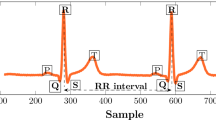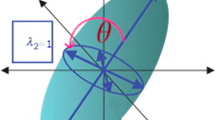Abstract
Efficient representation of linear singularities is discussed in this paper. We analyzed the relationship between the “wrap around” effect and the distribution of FRAT (Finite Radon Transform) coefficients first, and then based on study of some properties of the columnwisely FRAT reconstruction procedure, we proposed an energy-based adaptive orthogonal FRIT scheme (EFRIT). Experiments using nonlinear approximation show its superiority in energy concentration over both Discrete Wavelet Transform (DWT) and Finite Ridgelet Transform (FRIT). Furthermore, we have modeled the denoising problem and proposed a novel threshold selecting method. Experiments carried out on images containing strong linear singularities and texture components with varying levels of addictive white Gaussian noise show that our method achieves prominent improvement in terms of both SNR and visual quality as compared with that of DWT and FRIT.
Similar content being viewed by others
References
Candes E J, Donoho D L. Ridgelets: a key to higher-dimensional intermittency. Philos Trans R Soc A-Math Phys Eng Sci, 1999, 357(1760): 2495–2509
Starck J-L, Candes E J, Donoho D L. The curvelet transform for image denoising. IEEE Trans Image Process, 2002, 11(6): 670–684
Donoho D L. Ridge functions and orthonormal ridgelets. J Approx Theory, 2001, 111: 143–179
Donoho D L, Flesia A G. Digital Ridgelet Transform Based on True Ridge Functions. 2001, http://www-stat.stanford.edu/:_donoho/reports.html
Do M N, Vetterli M. The finite ridgelet transform for image representation. IEEE Trans Image Process, 2003, 12(1): 16–28
Matus F, Flusser J. Image representation via a finite Radon transform. IEEE Trans Pattern Anal Mach Intell, 1993, 15(10): 996–1006
Granai L, Moschetti F, Vandergheynst P. Ridgelet transform applied to motion compensated images. In: Proceedings of 2003 International Conference on Multimedia and Expo (ICME’03), 2003, 1: 561–564
Zhang P, Ni L. The curvelet transform based on finite ridgelet transform for image denoising. In: Proceedings of Seventh International Conference on Signal Processing (ICSP’04), 2004, 2: 978–981
Campisi P, Kundur D, Neri A. Robust digital watermarking in the Ridgelet domain. IEEE Signal Process Lett, 2004, 11(10): 826–830
Hou B, Jiao L C, Liu F. Image denoising based on ridgelet. In: Proceedings of Sixth International Conference on Signal Processing (ICSP’04), 2002, 1: 780–783
Liu Y X, Peng Y H, Zhou X H. Texture classification using finite ridgelet transform and support vector machines. In: Proceedings of Ninth Pacific Rim International Conference on Artificial Intelligence (PRICAI’06), 2006, 4099: 1042–1046
Nezamoddini-Kachouie N, Fieguth P, Jernigan E. BayesShrink Ridgelets for Image Denoising. In: Proceedings of International Conference on Image Analysis and Recognition (ICIAR’04), 2004, PT1: 163–170
Xiao X K, Li S F. Edge-preserving image denoising method using Curvelet transform. J Commun (in Chinese), 2004, 25(2): 9–15
Brodatz, Textures: http://www.ux.uis.no/:_tranden/brodatz.html
FRAT Toolbox: http://www.ifp.uiuc.edu/:_minhdo/software/frit_toolbox.tar.gz
Donoho D L, Johnstone I M. Ideal spatial adaptation via wavelet shrinkage. Biometrika, 1994, 81: 425–455
Chang S G, Yu B, Vetterli M. Adaptive wavelet thresholding for image denoising and compression. IEEE Trans Image Process, 2000, 9(9): 1532–1546
Sendur L, Selesnick I W. Bivariate shrinkage functions for wavelet-based denoising exploiting interscale dependency. IEEE Trans Image Process, 2002, 50(11): 2744–2756
Author information
Authors and Affiliations
Corresponding author
Additional information
Supported by the Scientific Research Foundation for the Returned Overseas Chinese Scholars, the Ministry of Education (Grant No. 2004.176.4), and the Natural Science Foundation of Shandong Province (Grant Nos. Z2004G01 and 2004ZRC03016)
Rights and permissions
About this article
Cite this article
Liu, Y., Peng, Y., Qu, H. et al. Energy-based adaptive orthogonal FRIT and its application in image denoising. SCI CHINA SER F 50, 212–226 (2007). https://doi.org/10.1007/s11432-007-0013-x
Received:
Accepted:
Issue Date:
DOI: https://doi.org/10.1007/s11432-007-0013-x




